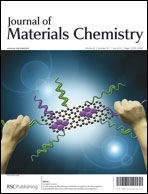The photophysical properties of Bi82+ and Bi53+ polycations stabilized by [AlCl4]− have been studied experimentally and theoretically. The obtained product was thoroughly evaluated by powder X-ray diffraction and photoluminescence spectroscopy, making it clear that both Bi82+ and Bi53+ contribute to the observed broad near-infrared emission. Furthermore, it was revealed that the Bi82+ polycation shows emission peaking at ca. 1180 nm, while Bi53+ shows the longer-wavelength emission. The following quantum chemistry calculation on the Bi82+ polycation helps us attribute some of the observed excitation bands in the visible spectral range to specific electronic transitions of bismuth polycations. It is believed that systematic investigation of structural and luminescent properties as well as detailed quantum chemistry calculation of molecular crystals containing such kinds of bismuth units allows us to obtain a clearer picture of bismuth-related photophysical behaviors, which not only serve to solve the confusions on the luminescence origin of bismuth in other material systems such as bulk glasses, glass fibers and conventional crystals, but also is helpful to develop novel applicable broadband tunable laser mediums.
![Graphical abstract: Experimental and theoretical studies of photoluminescence from Bi82+ and Bi53+ stabilized by [AlCl4]− in molecular crystals](/en/Image/Get?imageInfo.ImageType=GA&imageInfo.ImageIdentifier.ManuscriptID=C2JM30251A&imageInfo.ImageIdentifier.Year=2012)
You have access to this article
 Please wait while we load your content...
Something went wrong. Try again?
Please wait while we load your content...
Something went wrong. Try again?
![Graphical abstract: Experimental and theoretical studies of photoluminescence from Bi82+ and Bi53+ stabilized by [AlCl4]− in molecular crystals](/en/Image/Get?imageInfo.ImageType=GA&imageInfo.ImageIdentifier.ManuscriptID=C2JM30251A&imageInfo.ImageIdentifier.Year=2012)

 Please wait while we load your content...
Please wait while we load your content...